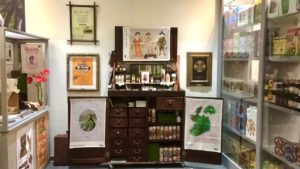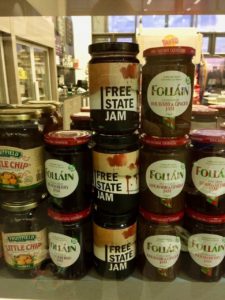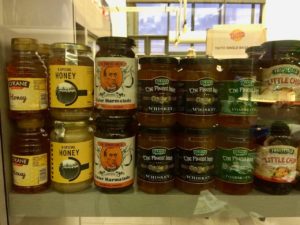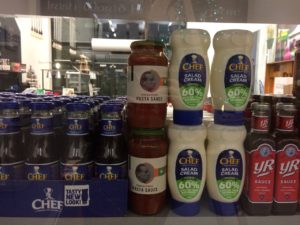Ulster artist Rita Duffy is splendid – like Mother Machree, she laughs – sitting next to the wood-burning stove, knitting an egg-yolk coloured square for the equally splendid patchwork curtain of her Achill cottage. We move on, as you do, to discussing the colour yellow. She tells how she met a miniaturist in India, who described the way cows are fed mangoes and their urine is then sun-dried to make a fine powder paint. She just hoped he washes his hands often.
I have invaded Rita’s month of creative solitude to talk about how we might work together on my “legacy” project. She met me in her battered Landrover at Knock, and we both delighted in this bizarre and utterly Irish phenomenon – an airport perched on top of a bog, inspired by the visionary priest Monsignor James Horan, whose bust adorns the arrivals hall and whose statue presides, arms outstretched like Christ the Redeemer over Rio, over the approach road. The airport even has a roundabout, for goodness sake, named after a Monsignor, Fr Domnic Grealy, another former parish priest of Knock.
I enjoy telling how I first flew, or tried to fly, into Knock in May 1986, for the official ribbon-cutting by Charles Haughey, among a planeload of journalists fuelled by a crate of champagne. The plane couldn’t land due to fog, and we were diverted to Shannon – but that is a story for another day ….

Rita Duffy is in Achill preparing for her next major exhibition, planned for the Highlanes Gallery in Drogheda in July. Images are pinned to the rough stone walls of the cottage. She’s applying the intense, vibrant techniques of the Indian miniaturists to a series with the working title “Ballads”, paintings on music sheets she has collected of old Irish songs, “the people’s Shakespeare”, songs of love, loss and betrayal, some with political and sectarian overtones from both loyalist and nationalist traditions.
Highlanes is a former Catholic church with stained glass and a marble altar. Duffy likes to respond to specific venues and to weave local narratives with broader historic, mythic and political themes. There are rich and eclectic pickings in Drogheda: the town motto is “In God Our Strength, in Merchandise Our Glory”, and Blessed Oliver Plunkett’s head resides in a shrine in St Peter’s Church (check out the website here).It is near Newgrange, and the Fleadh Cheoil will take place at the same time. “My job as an artist”, she says, “is to pick up the threads of interesting things people may have forgotten about.”

Her work last year was dominated by the Souvenir Shop, which was first shown in Dublin in 2016 as an Arts Council-sponsored exhibit celebrating the centenary of the Easter Rising. It travelled then to Skibbereen in Cork, and on to Paris and Pittsburgh, adapting to each venue as it went. In the Mattress Factory, Pittsburgh, she drew on African American images to link the civil rights movements in the US and Northern Ireland.
An ever-expanding collection of everyday products with an irreverent and whimsical take on the icons and memes of Irish history, Souvenir has its roots in her Shirt Factory exhibit in Derry, and Thaw, a pop-up shop on the Falls Road during the 2014 Féile An Phobail. A version can now be seen at the Irish World Heritage Centre in Manchester, where the products are mixed into the shop’s display, until the end of February. For Drogheda, the range will include souvenirs from Newgrange and Brexit biscuits. Later this spring it will be shown in Brussels, she hopes in the European Commission Centre.
All her work is political, Duffy says, and increasingly so. It mines deep veins of personal and national memory, identity and history and is often rooted in childhood memories.

She recalls coming home one dark January evening to her terraced house in Stranmillis from St Dominic’s School on the Falls Road – she was at first confused by the metal barriers in the road, until she saw that the Co-op corner shop was now a pile of rubble in a puddle of water. She can viscerally recall the panic – her own house was three doors down from the shop – that “came up through my feet and ankles”. The British-owned shop had probably been blown up by the UDA in a row over protection money. Her house was safe and the next day her mother banned her from joining the kids who were rifling through the debris for undamaged tins and jars.
Rita Duffy moved from Belfast to Fermanagh, disillusioned by the arts scene in Belfast, and her studio is now in an old courthouse in County Cavan. She has deliberately positioned herself at the margins, a powerful place to be in any system, none more so since Brexit has placed the border, which she crosses daily, into sharp relief. Last year, her installation, “Softening the Border”, of cushions and votive dolls, knitted by groups of local women, adorned the bridge between Black Lion in the South and Belcoo in the North.

Now, she is creating little paintings influenced by Mexican ex voto images – a way of witnessing events and giving thanks.Her work is, she says, less observational and literal than it used to be; it excavates memory and intuition, and is more “surreal, subconscious, subliminal, like meditation or prayer”. She is trying to “mend” herself, to stand upright, struggling with bigotry, “trying to work out why someone would put a loaf of Kingsmill bread on their head”.
All her work is influenced by her experience of being a Catholic from Belfast, where religious identity is national identity. Through her art she seeks to discover a new way of seeing, to enquire, to turn things upside down. She is looking for ways art can subvert the mentality of animosity and hatred – the stuff that causes dis-ease. At some stage, she says, we will have to let it go.
Rita Duffy’s The Souvenir Shop can be seen at the Irish World Heritage in Manchester until the end of February.
